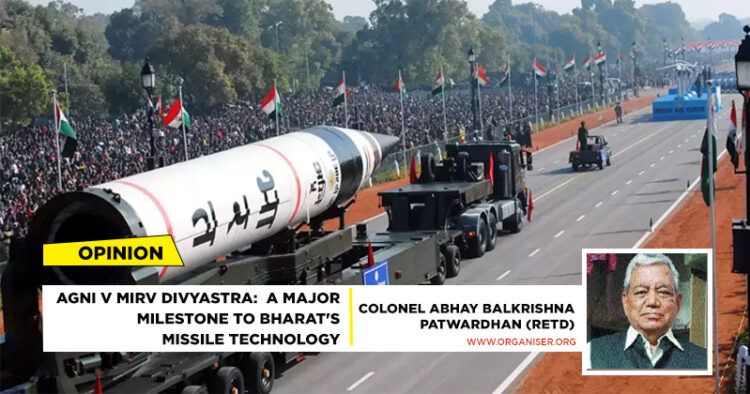On March 11, 2024, afternoon, the Indian Defence Research and Development Organisation (DRDO) successfully tested fired Agni V, a Multiple Independently Targetable Reentry Vehicle (MIRV) nicknamed Divyastra (Celestial Weapon),from an Island and one of the two Submarines parked in the Bay of Bengal, some 250 kilometers off the coast of Odisha, in the presence of Prime Minister Narendra Modi,who profusely appreciated the work of DRDO in this field.
America developed the First version of Land Launched Inter Continental Ballistic Missile, ICBM, in 1970 and Sea Launched Ballistic Missile, SLBM, in 1971-72. The Soviet Union followed suit before Britain, France, and China could. Pakistan also has tested MIRV Ababeei in 2017 as per some unconfirmed reports.
India has developed her MIRV Technology for fires from land and under sea. Submarine-based MIRV has a greater survivability index than land-based ones, as it is difficult to trace/find nuclear submarines. India has now developed a Flexible Deterrence with reference to China and Pakistan by checking existing Chinese Defence Strategies. Though India has proclaimed a strategy of “No First Use of Nuclear Weapons”, the success of MIRV can also be useful for her first strikes as per the demand of a changing situation.
MIRV is a missile system carrying several Multiple Nuclear Warheads, each independently targeted to a single or different enemy location, to be released at varying speeds and directions. It is capable of penetrating Enemy Defences by overwhelming its Defence System. Every single missile of Multiple Warheads of MIRV carries a number of Nuclear Warheads /small missiles which can hit several different targets at the same time or hit a single target with a load of all missiles. Its interception by the enemy’s Anti Missile System thereby becomes very difficult. MIRV is a combination of large/small Missiles, small warheads, accurate guidance and subsequent release of warheads during flight. As per Defence Experts, MIRV Divyastra can cover/ reach complete Asia, part of China, and a fringe of Europe, though its actual range and the number of warheads it can carry have not been made public by the government.
First, Russia and then America rejected/walked out of the ban on the START II MIRV Treaty in June 2002. Western defence experts were apprehensive that time that, after this, the field would be open for other countries to go for MIRV. After March 11, 2024, MIRV test by India, the same experts have opined that:
India has developed the capability for her Ballistic Missiles to strike more targets with fewer missiles.
India is now capable of conducting a decapitating, significant First Strike against Pakistan and maybe China, too, with very little advance warning.
Probable Silo Locations of Indian MIRVs would become more important targets for her adversary to destroy before they could be launched.
This might cause India to launch her MIRVs before they can be detected.
This huge success might prompt Indian decision-makers to try to preemptively disarm Pakistan in a given crisis.
This may/would allow India to add to its Nuclear Stockpile in the future if its plutonium production capability can utilise available, functional Breeder Reactors.
As per a report of the International Panel on Fissile Materials published in 2022, India has approximately 600-700 kilograms of weapon-grade plutonium sufficient for 138 to 213 Nuclear Warheads. As per the same Report, India has converted part of it to produce about 130-40 Nuclear warheads. It will certainly need more warheads to arm MIRVs, which is currently developing, which is/would be an alarming situation. The report further specifies that India produces weapon-grade Plutonium in Dhruva and Circus Plutonium production reactors at the Bhabha Atomic Research Centre complex. As per Jane’s Weapons Production Catalog of 2023, India plans to expand her Plutonium Production Capacity by building an additional Prototype Fast Breeder Reactor (PFBR). Once that is operationally ready, India will be next after Russia to have a commercially operating Fast Breeding Reactor.
The first user trial of an operationally configured 50 Ton Agni V Missile with 5000 kilometres range, and 11/2 Ton Single Warhead was conducted in 2021 under the Strategic Forces Command responsible for our Nuclear Arsenal. Chinese Dong Feng(DF), with a range of 12-15,000 kilometres,can reach anywhere in India. Agni V has brought the northernmost part of China and the whole of Pakistan within our Striking Range. The success of the MIRV Project would now enable India to penetrate the existing Missile Defense Systems of both China and Pakistan. It would also strengthen her No First Use Doctrine because of increased Deterrence Power and, at the same time, increase her First Strike Capability.
India has been able to take a far-reaching Strategic Leap in the Field of Missile Technology after testing Agni V MIRV Divyastra on March 11, 2024. This has enhanced our Strategic Power/Capability in the World. It is a matter of grave concern to Pakistan and China. In future; China dare not think of repeating Galwan again, neither Pakistan repeating Pulwama. A kadak Salute to DRDO.



















Comments